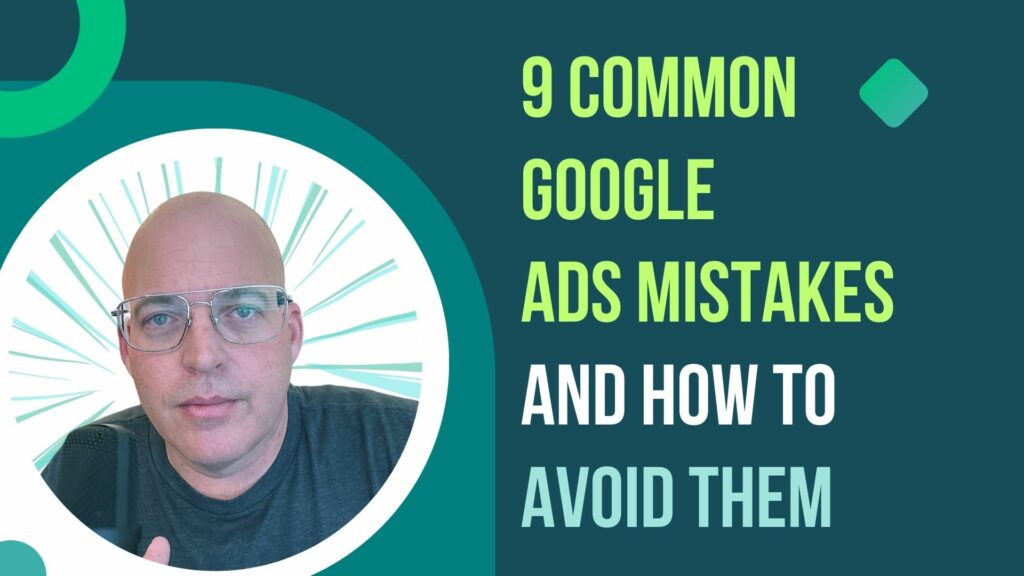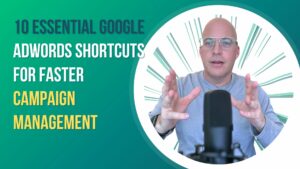In today’s digital-centric marketplace, Google Ads is vital for businesses looking to amplify their reach and drive targeted leads. Leveraging the power of search and display networks, it offers unprecedented opportunities for customer acquisition and engagement. Yet, for all its potential rewards. However, there are Google ads mistakes that are costly.
Google Ads also presents pitfalls that can deplete your marketing budget and undermine your campaigns if not managed carefully. To help you navigate this complex terrain, the focus of this guide is to elucidate nine commonly encountered Google Ads mistakes. Moreover, it offers practical solutions to avert these errors, aiming to optimize your advertising spend and maximize your ROI.
Poorly Defined Goals
Problem Description
One of the cardinal sins in Google Ads management is launching campaigns without well-defined objectives. Moreover, this often results in unfocused strategies and inefficient allocation of resources, making it difficult to measure success or failure.
Solution
The antidote is to adopt the SMART Goals framework, setting Specific, Measurable, Achievable, Relevant, and Time-bound objectives. Moreover, this clarifies your campaigns, helping you align your tactics with your larger business aspirations.
Pros and Cons
Pros: Implementing SMART Goals sharpens your focus, allowing for more precise targeting and better tracking through performance metrics.
Cons: Setting up SMART Goals can be labor-intensive at the outset, requiring careful thought and planning.

Inadequate Keyword Research
Problem Description
A common trap marketers fall into is using irrelevant or overly broad keywords in their Google Ads campaigns. Furthermore, this dilutes the focus and siphons off the budget without providing the desired results.
Solution
To remedy this, Google Keyword Planner can be a reliable ally. It helps you find targeted keywords that are not only relevant to your business but also likely to perform well in terms of search volume and competition.
Pros and Cons
Pros: Leveraging targeted keywords improves your reach, ensuring that your ads show up for the most relevant queries, thus enhancing the quality of your leads.
Cons: The downside is that keyword trends can shift, requiring you to constantly update your keyword list to keep up with market changes.
Neglecting Negative Keywords
Problem Description
Omitting negative keywords is like leaving a leak in your budget bucket; you’ll continually waste money on clicks that have no chance of converting. This can quickly deplete your ad budget without any real benefit.
Solution
The fix is straightforward: make it a habit to update and maintain a list of negative keywords continually. These are terms for which you don’t want your ads to appear, ensuring that only relevant audiences engage with your campaign.
Pros and Cons
Pros: Employing a well-curated list of negative keywords will make your campaigns more cost-effective by filtering out irrelevant clicks, thereby increasing your ROI.
Cons: The challenge is continuously monitoring and updating your negative keyword list to adapt to changing user behaviors and market trends.

Not Utilizing Ad Extensions
Problem Description
Skipping ad extensions is a missed opportunity to offer potential customers more reasons to click your ad. You may be sacrificing valuable real estate in the search results by not providing additional information like site links or callouts.
Solution
Use various ad extensions such as site links, callout extensions, and structured snippets to capitalize on this. These extensions offer extra details to make your ad more appealing and informative, encouraging higher click-through rates.
Pros and Cons
Pros: Incorporating ad extensions enhances the user experience by delivering more information right on the search results page, which can improve your ad’s performance.
Cons: The downside is that setting up these extensions requires time and effort to ensure they align with your overall campaign objectives.
Poor Landing Page Experience
Problem Description
Directing traffic to an ineffective landing page is akin to throwing a party and forgetting to send out invitations; the room will remain empty. High bounce rates and low conversions often stem from a landing page that is not aligned with the ad’s promise or is too slow to load.
Solution
The key to fixing this lies in optimizing your landing pages for relevancy to the ad content and load speed. The page should fulfill the promise made in the ad and be quick to load to keep the visitor engaged.
Pros and Cons
Pros: A well-optimized landing page can dramatically boost conversions, turning potential customers into actual sales or leads.
Cons: The optimization process can be resource-intensive, requiring both time and technical know-how to improve the design, content, and speed of the page.

Ignoring Mobile Users
Problem Description
Overlooking the mobile user base is a strategic misstep, especially in a world where smartphones are an extension of our hands. Campaigns not optimized for mobile can lead to poor user experience and lower engagement.
Solution
The solution is to create mobile-optimized ads and landing pages. Moreover, this ensures your campaign appeals to the growing segment of users accessing search and other mobile services.
Pros and Cons
Pros: Going mobile-friendly broadens your reach, giving you access to a larger, often more engaged audience who primarily or exclusively use mobile devices.
Cons: The challenge is that mobile optimization involves additional design and testing efforts to ensure your content looks good and performs well on various screen sizes.
Poor Ad Copy
Problem Description
An ad with uninspiring copy is like a shop with a dull storefront; few people will be inclined to enter. If your ad copy lacks a compelling message or clear call-to-action, it’s unlikely to entice users to click, leading to poor performance metrics.
Solution
To revamp lackluster ad copy, focus on using compelling and clear language. Moreover, consider integrating persuasive elements like unique selling points, benefits, and a strong call to action to improve engagement.
Pros and Cons
Pros: Well-crafted ad copy can significantly improve your click-through rates, making your campaign more cost-effective by increasing the likelihood of conversions.
Cons: Finding the optimal ad copy usually involves A/B testing, which can be time-consuming as it requires creating multiple ad variants for comparison.

Lack of Tracking and Analysis
Problem Description
Operating Google Ads campaigns without tracking metrics is like sailing without a compass—you’re moving, but it’s hard to tell if you’re heading in the right direction. Furthermore, the absence of proper tracking and analysis deprives you of the data to gauge your campaign’s effectiveness.
Solution
The answer lies in implementing tracking tools like Google Analytics and consistently monitoring Key Performance Indicators (KPIs) such as click-through rates, conversion rates, and ROI. This data-driven approach allows for precise tweaks and improvements to your campaigns.
Pros and Cons
Pros: Access to in-depth analytics equips you with informed decision-making, enabling constant refinement of your campaigns for better results.
Cons: The volume and depth of data available can be overwhelming initially, necessitating a learning curve to understand which metrics are most relevant to your objectives.
Failing to Optimize for Local Searches
Problem Description
Ignoring the local aspect of Google Ads is akin to a local shopkeeper turning a blind eye to neighborhood customers. Moreover, this oversight leads to missed opportunities for local businesses that could benefit from geographically targeted ads.
Solution
The way to tackle this is through Geo-targeting features available in Google Ads. Moreover, by setting your ads to display only in certain locations, you increase the likelihood of attracting local customers who find your offerings relevant to their immediate needs.
Pros and Cons
Pros: Using Geo-targeting enhances local relevance, making your campaign more effective in capturing the attention of prospective customers in specific regions.
Cons: The downside is that such targeting can limit your ad’s reach to a broader, non-local audience, depending on how tightly you set the geographical parameters.
Charting a Smoother Course in Google Ads Mistakes Charter
Navigating the complexities of Google Ads mistakes can be akin to sailing through choppy seas, where common pitfalls like poorly defined goals, inadequate keyword research, and neglecting mobile users can quickly steer you off course. But equipped with the right strategies—from setting SMART goals to optimizing landing pages and implementing robust tracking—you’ll find yourself better positioned to reach your destination. The road to mastery is continual learning and adaptation, so don’t let early google ads mistakes deter you. Instead, view them as valuable lessons that sharpen your skills for the many campaigns ahead.

Frequently Asked Questions
How Often Should I Update My Keyword List?
Regular maintenance is advisable. A monthly review is a good starting point, but high-competition industries may require weekly updates.
How Do I Know if My Landing Page is Effective?
An effective landing page typically has a low bounce rate and a high conversion rate. Moreover, tools like Google Analytics can monitor these metrics.
Is Mobile Optimization Worth the Extra Effort?
Given the growing number of mobile users, failing to optimize for mobile can mean missing out on a portion of your potential audience.
How Many Ad Variations Should I Create for A/B Testing?
The number varies based on your campaign size and budget, but a common approach is testing at least two to three different ad copies.
How Does Geo-targeting Work?
Geo-targeting allows you to display your ads only to users in specified locations, increasing the likelihood of attracting local customers.
Can a Small Business Benefit from Google Ads?
Absolutely. With proper targeting and budget management, Moreover, Google Ads can be a cost-effective way for small businesses to attract new customers.








